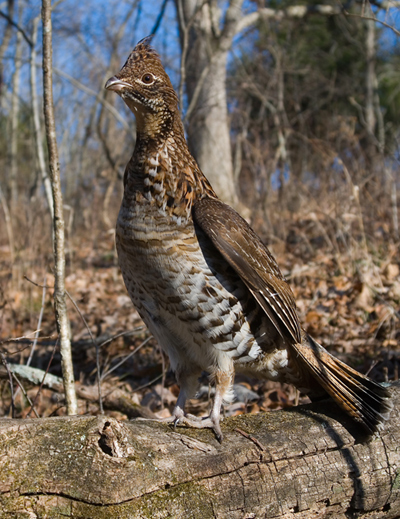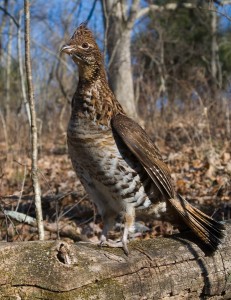
Kentucky Dept. of Fish and Wildlife Resources News
Kentucky Afield Outdoors:
Ruffed grouse battling changes in habitat and high natural mortality
Jan. 27, 2011 Contact: Art Lander, Jr.
FOR IMMEDIATE RELEASE 1-800-858-1549, ext. 4414
FRANKFORT, Ky. – The ruffed grouse (Bonasa umbellus), a medium-sized, non-migratory bird found throughout the mountains of Appalachia, has an interesting history in Kentucky.
No one knows for sure how widely distributed grouse were during the pre-settlement era when old-growth forests covered an estimated 90 percent of the state.

It’s been well-documented that as Kentucky’s big timber was cut, grouse sightings in the region increased. In recent decades, the reverse has been true — grouse population densities have severely declined as Appalachia’s forests matured.
“Historically, grouse populations have most likely gone up and down with forest condition,” said Dan Figert, assistant director of wildlife for the Kentucky Department of Fish and Wildlife Resources, and former small game program coordinator. “In mature forests, grouse survive, but they don’t thrive. They are really an early successional species. They do best in forests with several different age classes of trees.”
After 1930, when most of the Cumberland Plateau had been timbered, grouse numbers increased, offering good hunting for several decades beginning in the 1940s.
In the March 1950 issue of Happy Hunting Ground magazine, Frederick C. Hardy, Federal Air Project Leader, reported that “cutting the climax forest, which helped spell doom for deer and turkey, actually improved grouse habitat. Grouse populations are being studied by drumming counts and flushing counts. Drumming sites were almost without exception located on uplands, in second-growth hardwoods, as are a majority of nests.”
The grouse is an omnivorous bird that spends most of its time on the ground, eating buds, leaves, berries, seeds and insects.
It requires second growth forests for food, cover and nest sites.
Males attract females by drumming or rapidly flapping their wings. Hens typically lay 10 to 14 eggs, which hatch in 23 days. Chicks, which stay with hens until late September, are fully grown in 16 weeks.
Grouse have a high natural mortality rate, so reproductive success is important to maintain population levels. In the north woods of the U.S. and Canada, grouse experience regular population cycles (highs and lows) every 10 to 12 years.
“Appalachian populations of grouse occur in much lower densities, but populations are more stable,” said John Morgan, small game program coordinator for Kentucky Fish and Wildlife.
In an attempt to expand the range of grouse in Kentucky, birds were stocked at Land Between the Lakes beginning in the early 1980s. During the 1990s, the trap and relocation efforts extended to several counties in central Kentucky, Pennyrile State Forest and Ft. Knox Military Reservation.
“There were some initial successes, but over the past decade populations have largely disappeared,” said Morgan. “We occasionally get reports of grouse sightings in central Kentucky and we had one in Hart County a few years back.”
Daniel Boone National Forest, the state’s largest area open to public hunting for grouse, has had no significant timber harvest in the past 20 years. “Without question, a lack of early successional forest habitat has impacted grouse populations and hunter harvest in the forest,” said Morgan.
While timber harvest on private lands may have benefitted some local populations of grouse, the maturation of forests in Appalachia continues to be the driving force behind long-term population declines. Two natural events created some forest openings: the February 2003 ice storm that damaged thousands of acres of hardwood trees, and infestations of the southern pine beetle, first reported in the spring of 2000. However, Morgan said the overall benefit to grouse populations has been negligible.
Typically, there is a spike in hunting activity, flush rates and grouse harvest during the final weeks of the season based on the annual Grouse Hunter Log Survey.
“The leaves are off the trees, and ground cover is broken down (by snow and wind), so it’s much easier to see and get a shot at flushing grouse,” said Morgan. “Also, food is more limited, so birds spend more time moving around which makes them more susceptible to hunting.”
Morgan estimates the number of Kentucky grouse hunters at about 15,000. “But we do know that on average it takes three to five hunts to harvest a single grouse,” he said.
Today, grouse hunting season in Kentucky is legal in 53 counties. The split season is 118 days long. Grouse season opened Nov. 1 and closed Nov. 12, 2010. The season opened again Nov. 15 and will close Feb. 28, 2011.
The daily bag limit is four grouse.
–30–
The Kentucky Department of Fish and Wildlife Resources manages, regulates, enforces and promotes responsible use of all fish and wildlife species, their habitats, public wildlife areas and waterways for the benefit of those resources and for public enjoyment. Kentucky Fish and Wildlife is an agency of the Tourism, Arts and Heritage Cabinet. For more information on the department, visit our website at fw.ky.gov.


I have been a grouse hunter since 1965. February should not be open to grouse hunting.hunting pressure is to high for maintaining good grouse population